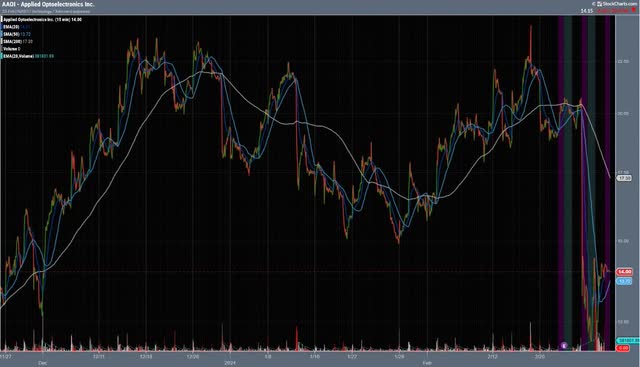
Pratchaya
I covered Applied Optoelectronics (NASDAQ:AAOI) last December on Seeking Alpha. The stock continued its uptrend ultimately hitting $25 per share around February 15. The stock price zig zagged up and down during this time, which allowed my short-term call options strategy great success. I also added shares to my long-term position during this time. I had bought shares around the $18 mark.
News of Applied Optoelectronics’ weak Q1-2024 outlook tanked the stock price last week. The company expects lower revenues and a net loss for Q1-2024. Applied Optoelectronics’ Q4-2023 earning report was strong, but came in below expectations. The company foresees better financial results after Q1 for the rest of 2024. Regardless of the positive long-term forecast, the company’s stock dropped severely last Friday. The price lost over 30%, dropping under $12 per share before regaining some ground during after-market.
In my opinion, the price will begin a new uptrend after investors fully digest Q4-2023 results and Q1-2024 forecasts. I continue my rating of Buy and recommend that investors reload their positions. I am reloading my positions. If the stock begins a new uptrend, it should recover most of the 30% drop, offering impressive gains. The options market for Applied Optoelectronics has not returned to normal yet, but once it does, the short-term strategy will be viable again. Holding the stock now is a high risk while this revaluation process goes on between investors and the stock price.
Applied Optoelectronics manufactures and sells fiber optics networking products which are used by telecom, cable TV, and datacenters. The company’s products are in high demand for any company using data infostructure and data broadcasting. AI technology is furthering the industry-wide demand for the company’s products.
Applied Optoelectronics’ Q4-2023 Results
The company reported financial results, which showed improvement YoY and QoQ, but came in below the company’s expectations. Applied Optoelectronics reported total revenue of $60.5 million, representing a 1.94% decrease YoY and a 3.2% decrease QoQ. Lower revenue was caused by lower demand in data center products. The company reported a positive adjusted EBITDA of $4.8 million and a net income of $1.6 million or $0.04 per share. The most impressive metric was the company’s non-GAAP gross margin, which came in at 36.4% and represents a historical high for the company.
Revenue for data-center products was $44.5 million, which doubled YoY, but decreased 9% QoQ. The company says that demand for its 100G and 400G products continues to increase YoY. Revenue for its CATV segment was $12.6 million, which was down 67% YoY, but up 22% QoQ. The company says that
CATV segment has decreased due to slower sales of DOCSIS 3.1 products as the industry switches to DOCSIS 4.0 systems. 74% of the company’s revenue was from data center products; 21% was from CATV products; 5% was from FTTH, telecom, and other products.
The company reported that CATV business will remain weak until the transition into the next gen tech for MSOs (multi-system operators), which will begin in the middle of 2024. The company has already sent out samples of its 1.8 Ghz amplifier products to two MSOs in Q4. It expects revenues from new gen products between April and June 2024. As MSOs upgrade to DOCSIS 4.0 (data over cable service interface specifications), the company will be ready to supply the new system products.
Data center revenue makes up the majority of the company’s overall revenue. 56% of the company’s data center revenue was from 100G products, 36% was from 200G and 400G products, and 4% from 40G transceiver products. The Increase in 200G and 400G products is from the higher demand of computer infrastructure for AI computing. The company has sent out 800G samples to other data centers and expects shipments of these products to begin during Q3-2024.
In 2023 the company made two agreements with Microsoft to provide next gen lasers for its data centers both for 400G and next gen active optical cables. Revenue for this project will continue with the company’s 800G products and beyond. The company expects $300 million from the contracts over the next quarters of data center build-outs.
The company’s telecom segment revenue was $2.8 million, which was down 56% YoY and down 8% QoQ. The company expects softer demand for 5G products in China to continue. This segment will remain weak inline with weak demand.
Operating expenses were $21.6 million or 35.7% of revenue. Operating expenses remained the same YoY. Operating expenses will increase slightly in the next quarter due to the acceleration of R&D associated with the development of 800G and 1.6 terabit data center products.
Cash and short-term investments at the end of Q4-2023 were $55.1 million. The company reported total debt (not including convertible debt) at $38.7 million. At the end of Q4-2023, company had $63.9 million in inventory. The company used $8.7 million in capital investments during Q4 used for production and R&D equipment.
Q1-2024 Outlook
Applied Optoelectronics forecasts a dismal outlook for Q1-2024, but predicts better results for the rest of the year, as demand for next gen tech revamps. The company expects Q1-2024 revenue to be between $41 and $46 million, representing a decrease QoQ. The company expects margins between 21%-23%, also representing a decrease. Net loss between should be between $10.9 million to $12.6 million or between $0.28 per share to $0.33 net loss per share.
Beyond a weak Q1, Applied Optoelectronics sees several synergies for the rest of the year. The company reports new data center customers for its 400G and 800G products. Q2-2024 should reflect the results of these new customers. The company will introduce its 1.6 terabit products in 2025. The company foresees AI computing to keep the demand for their products growing.
Historical Performance and Valuation
|
Amounts in US$ Millions |
Q1-2024 |
Q4-2023 |
Q3-2023 |
Q2-2023 |
Q1-2023 |
Q4-2022 |
|
Revenues |
est. 41.0 |
60.5 |
62.5 |
41.6 |
53.0 |
61.6 |
|
Cost of Revenues |
38.8 |
42.4 |
33.7 |
43.8 |
55.4 |
|
|
Gross Profit |
21.6 |
20.2 |
7.9 |
9.2 |
6.2 |
|
|
Total Operating Expenses |
26.1 |
26.9 |
23.9 |
23.4 |
24.6 |
|
|
Operating Income |
(4.5) |
(6.7) |
(16.0) |
(14.2) |
(18.4) |
|
|
Net Income |
est. (10.9) |
(13.9) |
(9.0) |
(16.9) |
(16.3) |
(20.3) |
|
Cash & ST Investments |
55.1 |
21.9 |
21.6 |
16.1 |
24.7 |
|
|
Accounts Receivable |
48.1 |
60.8 |
42.6 |
56.8 |
61.2 |
|
|
Total Current Assets |
172.6 |
164.4 |
144.5 |
161.5 |
183.2 |
|
|
Total Long-Term Assets |
389.2 |
373.8 |
356.9 |
383.6 |
408.3 |
|
|
Accounts Payable |
32.9 |
34.9 |
35.1 |
38.4 |
47.8 |
|
|
Total Current Liabilities |
93.4 |
188.2 |
187.5 |
205.6 |
138.6 |
|
|
Total Long-Term Liabilities |
174.3 |
195.4 |
193.6 |
210.9 |
223.6 |
|
|
Unlevered Free Cash Flow |
(18.0) |
25.5 |
(2.4) |
1.8 |
||
|
Current |
Q4-2023 |
Q3-2023 |
Q2-2023 |
Q1-2023 |
Q4-2022 |
|
|
Price |
14.15 |
19.32 |
10.97 |
5.96 |
2.21 |
1.89 |
|
Total Enterprise Value |
575.42 |
805.34 |
476.27 |
314.13 |
195.05 |
178.69 |
|
Market Cap |
509.44 |
695.58 |
365.77 |
174.01 |
64.21 |
53.91 |
|
NTM Total EV / Revenues |
2.00x |
2.75x |
1.75x |
1.55x |
0.80x |
0.71x |
|
Book Value / Share |
5.88 |
5.20 |
5.14 |
5.94 |
6.45 |
|
Financial data from Seeking Alpha and valuations from TIKR.com
On the positive side, Applied Optoelectronics has managed to increase its margins and gross profits over the last five quarters. The company’s net loss has decreased as well, although there is more room to improve. The company’s cash on-hand is increasing, but it is not consistently reporting free cash flow.
If the company continues to increase its profit margins over 2024 and is able to decrease its net loss, then there will be marked improvement. In the best scenario, there would be net gain and positive cash flow. Since the company sells technology, which is constantly being upgraded, there is an ebb and flow with the supply and demand of its sector. Applied Optoelectronics expects revenues and profits to increase over 2024, as next gen technology demand increases. This trend requires that demand for the old gen technology decreases.
As to valuation, the company was already considered overvalued and is now undergoing downgrading due to the weak Q1-2024 forecast. Further investment in this stock will come as a high-risk rating. According to its next twelve months enterprise value divided by revenues, the company remains undervalued and its stock price has room to increase. The AI aspect of this company’s future success may be considered here. The demand for its products will continue to be high.
Stock Price Movements

www.stockcharts.com
Since I last covered Applied Optoelectronics, the company’s stock price was on an uptrend. It lost support in mid-January and regained support in February. The zig-zag motion of the price movements can be seen in this three-month price chart. The colored vertical lines on the right represent price activity after market, when the stock price decreased the most. The price will likely come back up to $16 or $17 per share to reflect its previous fluctuations before earnings.
The stock price downtrend broke its one-year record returns. It is now up 365% over the last twelve months versus its 900%-1000% twelve-month uptrend observed in my last article. The company’s stock is still undergoing short-squeeze conditions with 92% share float. The stock still enjoys high institutional ownership at 68.88% and this may be the reason that the stock price will regain higher price channels.
There is a chance that the stock price will remain low and stay in lower price channels for some time.
Risk and Investment Strategy
There is no risk in the company’s current business strategy and it will continue to fulfill its immediate and long-term business goals. An investment strategy in Applied Optoelectronics is now high risk, since the company is considered overvalued and is being downgraded by investment firms.
In my last coverage of the company, I took a contrarian approach and continue to take such an approach. I recommend a long-hold strategy, through 2024, with the hope that the stock price returns to the $18-$20 per share price range. I had recommended a short-term call options strategy. I will recommend this strategy again, once the stock price returns to weekly uptrends and the call options volume returns to normal. I now set stop loss at $12.50 per share. It is possible the stock will continue its downtrend and not return to pre-earnings glory. This week will hopefully confirm a new trend or direction in price movement.
Conclusion
Through January and February, Applied Optoelectronics stock price continued its uptrend as my last coverage predicted. The price hit a high point of $25 per share before the trend changed. During the two months, the stock price went up and down in such a way as to allow one to play continuous short-term call options strategies. After the company announced Q4-2023 along with s dismal Q1-2024 forecast, the stock price fell over 30%. I remain convinced that the company’s stock price will return to a higher channel as investors fully digest its earnings reports and outlook. The company’s products are in high demand and the trend of AI computing will keep this demand high. The company is well positioned to meet the needs of next generation technologies at datacenters and for MSOs. I keep my rating of a buy and recommend reloading on the dip.
